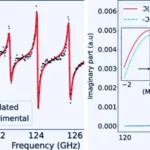Scientists utilizing the H.E.S.S. observatory in Namibia have made an astounding discovery, capturing the highest energy gamma rays ever emitted from a deceased star known as a pulsar. These gamma rays exhibited an unprecedented energy level of 20 tera-electronvolts, approximately ten trillion times greater than the energy of visible light. Published in the journal Nature Astronomy, this finding challenges existing theories on producing pulsed gamma rays.
Pulsars are remnants of stars that underwent spectacular supernova explosions, leaving behind a compact, fast-rotating dead star with an immense magnetic field. These dead stars, primarily composed of neutrons, are incredibly dense, packing over five billion tonnes of mass into a mere teaspoon of material. Pulsars emit rotating beams of electromagnetic radiation resembling cosmic lighthouses, and when these beams intersect with our solar system, we observe periodic flashes of radiation known as pulses. The source of this radiation is fast electrons generated and accelerated in the pulsar’s magnetosphere as they journey toward its periphery. However, the recent observation challenges conventional theories. The Vela pulsar, situated in the constellation Vela in the Southern sky, is a prominent pulsar emitting radiation primarily in the radio and gamma-ray bands of the electromagnetic spectrum. The Vela pulsar’s radiation typically ends in the gigaelectronvolts (GeV) range, indicating the escape of electrons from the pulsar’s magnetosphere.
In a groundbreaking development, utilizing the H.E.S.S. observatory, researchers discovered a new radiation component at remarkably higher energies, reaching tens of tera-electronvolts (TeV). This component was about 200 times more energetic than any radiation previously detected from the Vela pulsar. This unexpected high-energy component manifested in the same phase intervals as the lower-energy one observed in the GeV range, challenging conventional understandings of pulsar behavior. This discovery significantly challenges the existing knowledge about pulsars, necessitating a reevaluation of the functioning of these natural accelerators. The observed extreme radiation pushes the boundaries of what was previously understood, whether through magnetic reconnection processes beyond the light cylinder or other mechanisms.
The Vela pulsar’s groundbreaking discovery sets a new standard for pulsars, opening a new observational window to detect other pulsars in the tens of teraelectronvolt range. This breakthrough promises a deeper comprehension of extreme acceleration processes in highly magnetized astrophysical objects, unlocking exciting possibilities for future research and understanding the cosmos at a more profound level.










